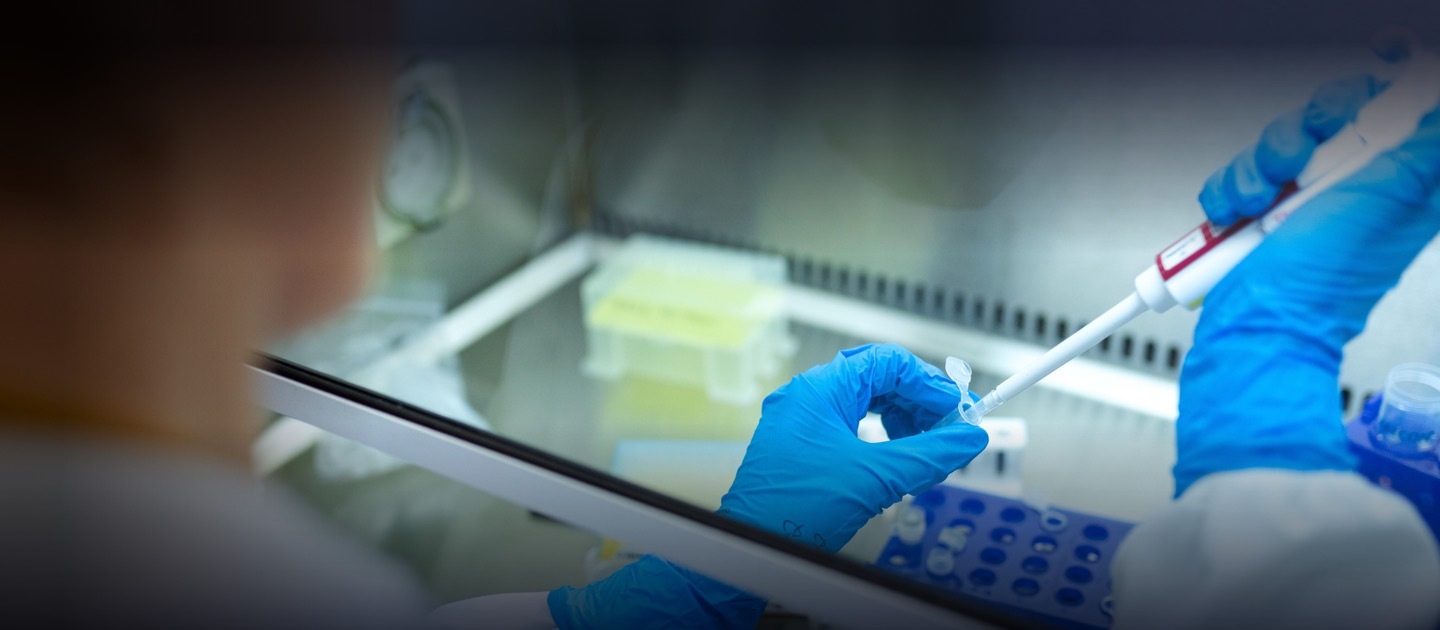
Researchers from Beijing’s Tsinghua University Visit UC Chile to Explore Areas of Scientific Collaboration
The visit by a delegation of distinguished researchers from Tsinghua University—a leading university in China and Asia—aims to foster joint initiatives and academic exchange in biological and medical sciences at UC Chile. Notably, the delegation included the first scientist to capture a high-resolution image of the coronavirus, making a substantial contribution to its study and vaccine development.
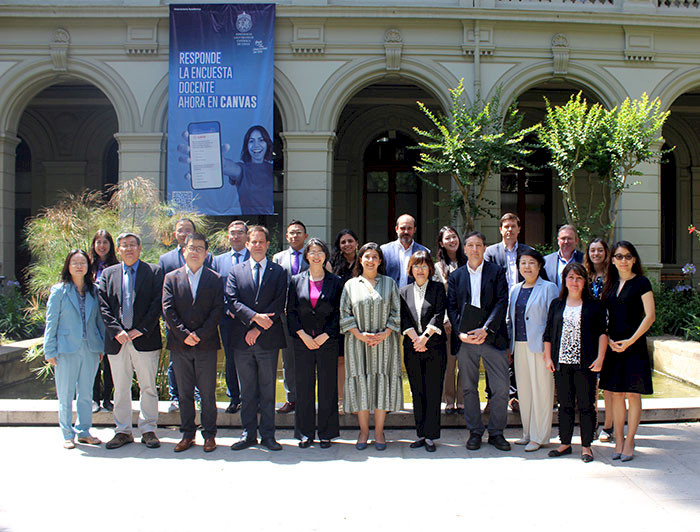
photo_camera A delegation of 15 members from Tsinghua University in China visited UC Chile to explore potential international collaborations, particularly in the field of health sciences. (Photo by: Pía Billa)
During the initial stages of the COVID-19 pandemic, when knowledge about the virus was limited, Dr. Sai Li, a structural biologist and professor in the Department of Life Sciences at Tsinghua University in Beijing, reached out to a virology team in Hangzhou to secure samples.
Despite concerns about the safety of the chemically fixed (inactive) samples, Dr. Li spent almost two months convincing the university of their safety. Eventually, he succeeded and conducted experiments in a level 3 biosafety laboratory on an empty university campus during the pandemic. "We were only four people: a student, a postdoctoral student, a technician, and myself," he recalled. The team worked tirelessly for a hundred days. "It was very stressful," he confessed.
"We froze the virus at a very, very low temperature: -190ºC, and we had to do it very quickly for it to freeze in its natural state," said the professor. Any mistakes during this process could have resulted in ice crystals piercing the viruses and altering or destroying their structure.
Furthermore, since viruses are so extremely small, with a diameter of only 100 nanometers, they cannot be viewed using an optical microscope. Instead, Dr. Li had to use a cryo-electron microscope, a technique in which he has expertise. The device fired electron beams at the sample while reconstructing the virus image on the computer.
I inquired, "What was your experience like seeing the virus for the first time?" He replied, "It was remarkable." "When we first saw the image from the microscope, we had a screen full of viruses. It was very exciting and also very terrifying. To be honest, the virus looks very beautiful. Its shape is very unique. It's very exciting, although my students were a little scared; they are very young and had never seen anything like this before."
The image circled the globe, and Dr. Li was even interviewed by the New York Times. His goal was to aid the then-emerging research on SARS-CoV-2, so he made the image as widely accessible as he could. He developed animated images in collaboration with a computer vision team, with great scientific precision.
“When we first saw the image from the microscope, we had a screen full of viruses. It was very exciting and also very terrifying.” - Sai Li, structural biologist and professor at Tsinghua University.
He also reached out to the Chinese company CanSino BIO for the development of one of the first COVID-19 vaccines. "This vaccine uses adenovirus to introduce the antigen sequence into our body, using our body to express the antigens and stimulate the immune response to create specific antibodies against this virus. We received vaccines from the company and took many images of the expressed antigens, we then made our recommendations," he explained. Dr. Li's team also took images of various virus variants for comparison.
At present, Dr. Li and his team of 10 members are concluding one of their investigations, observing viruses incubated with neutralizing antibodies to understand the mechanism by which the antibodies neutralize the virus. “We are trying to explore novel mechanisms to explain this neutralization. It’s groundbreaking work," he said. Additionally, he has sub-teams working with influenza and smallpox viruses.
Visit to UC
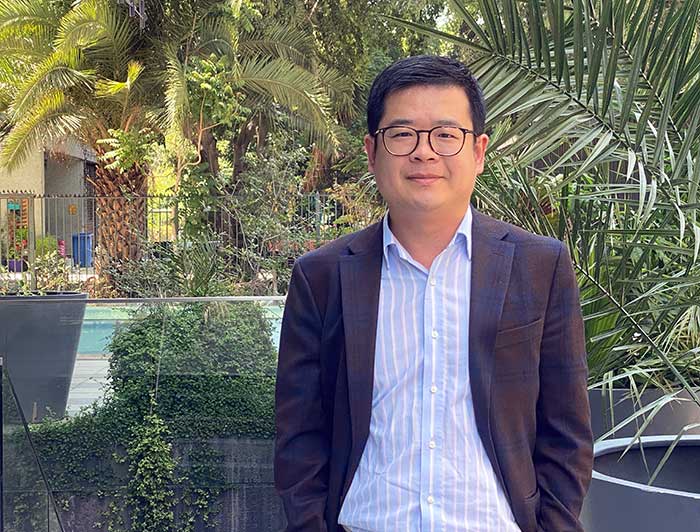
Dr. Sai Li is part of the delegation of 15 members from Tsinghua University who visited UC Chile from December 10th to the 14th. The visit aimed to foster joint initiatives between both institutions, especially in the field of health science.
The delegation was received by Vice President of International Affairs Lilian Ferrer, Vice President for Research Pedro Bouchon, and the directors of the Faculty of Biological Sciences, the Faculty of Medicine, and the Millennium Institute on Immunology and Immunotherapy (IMII, by its acronym in Spanish).
"The significance of such visits and the creation of opportunities for collaboration in research and academic exchange between UC Chile and global universities cannot be overstated. As Tsinghua University is a leading university in China, collaborating with them means we are working with top-tier researchers to foster ongoing advancements in academic cooperation, especially in important domains like life sciences,” highlighted Vice President Lilian Ferrer.
"We maintain a close collaboration with Tsinghua University in various fields. Our partnership notably intensified throughout the COVID-19 pandemic, leading to this visit of experts in medicine and biological sciences aimed at bolstering cutting-edge research. Particularly noteworthy is the pivotal role played by one of the delegation's researchers in characterizing the virus. Our aim in this meeting is to strengthen our ties, foster new projects, enrich doctoral training, and promote academic exchange," said Vice President Pedro Bouchon.
At the Faculty of Biological Sciences, the delegation was welcomed by the director of the IMII, Alexis Kalergis, and academics Alejandra Álvarez, Gareth Owen, and Pablo González, all professors of the faculty.
Dr. Qiaoran Xi, a professor in the School of Life Sciences at Tsinghua University, initiated the bilateral meeting by presenting the main axes of her research regarding TGF-Beta signaling, cancer, and stem cells. She also gave a brief introduction to Tsinghua University, highlighting its focus on scientific research and its goals in terms of international collaboration.
This was Professor Qiaoran Xi’s first visit to South America, and she found UC Chile's facilities to be quite impressive. She also mentioned that she sees great potential for collaboration between the two universities, especially in the fields of oncology, neuroscience, and immunology. "There are several common points where collaboration can happen," she said.
For his part, Professor Li Sai was pleasantly impressed by the academic level in Chile. Concerning his area of expertise, he explained, "Dr. Alexis Kalergis focuses on the effectiveness of vaccines, working in applied science. In contrast, my work revolves around the mechanisms preceding vaccine development. My inquiry delves into the fundamental aspects of how and why these vaccines are effective—namely, the domain of basic science."
However, he sees the possibility for collaboration between laboratories at Tsinghua University and UC Chile in the form of doctoral research internships. "For example, if I acquire a virus or vaccine construct from Chile, I can dispatch a student here to acquire the skills in cell cultivation and virus propagation. Then, they return to analyze the structure and so forth."
For Professor Qiaoran Xi, the main challenge lies in funding. "In general, the government provides funding to encourage researchers to collaborate with other countries, but we haven't seen any for Chile. So, upon returning to China, we can see if there is any possibility of providing funding opportunities that, I believe, would improve connections," she said. She also mentioned that several pharmaceutical companies fund research projects, and Tsinghua University has some internal funds.
For Professor Li Sai, the biggest challenge is having level 3 or 4 biosafety laboratories, which are essential for handling highly infectious biological agents with the highest standards. These laboratories are costly to maintain and require qualified personnel, and there are very few of them worldwide.
During the working meetings, presentations were also given by Alexis Kalergis, "The Scientific Basis for Vaccine Efficacy and the Immunity Controlling the COVID-19 Pandemic"; Gareth Owen, who delved into advances in studies on cancer cells; and researchers Jing Ma, Suxi Gu, Catterina Farreccio and Julian Varas, who addressed topics such as robotics in surgery, epidemiology, innovation, and public health in Chile and China.
Building Bonds
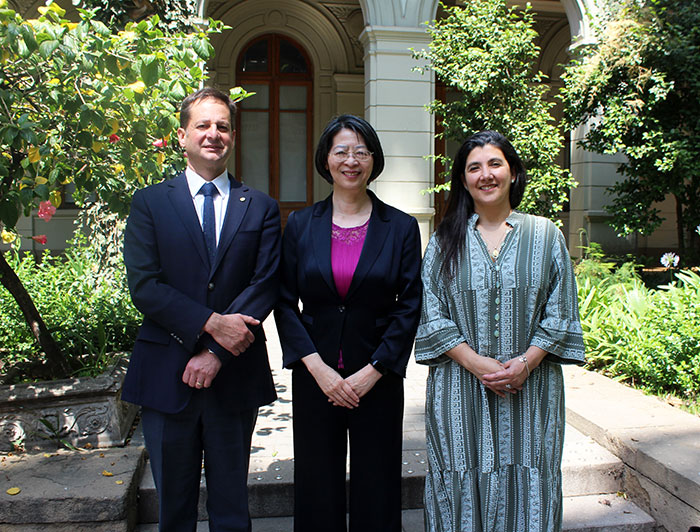
This visit is part of a broader context of collaboration between both universities, involving various initiatives.
Last October, Vice President of International Affairs Lilian Ferrer visited Tsinghua University, where she was received by Hongwei Wang, Vice President of the Administrative Committee of Tsinghua University. They discussed mutual interest in further exploring aspects such as "Internationalization At Home," academic mobility, the cultivation of global competencies, and extending collaboration to areas such as astronomy, health, arts, and business.
Before this meeting, Professor Taotao Chen from the Faculty of Economics and International Business at Tsinghua University had visited UC Chile in August, touring the UC Innovation Center and the Central Campus, both placed in Santiago of Chile, showing great interest in the academic offerings and the advances made by UC Chile in entrepreneurship, innovation, and business at the national level. Previously, in 2022, Dr. Linqi Zhang, a professor of the Faculty of Life Sciences, had been in Chile as an international guest speaker at the Immunology Symposium organized jointly by the Millennium Institute of Immunology and Immunotherapy (IMII, by its acronym in Spanish) and UC Chile.
Additionally, both universities have engaged in joint activities, such as the "Chile | China Global Conversations About Arts & Culture" program and the Summer University Program, which allowed students from the International Business, Architecture, and Environmental Sciences programs at Tsinghua University to visit UC Chile campuses and research centers in August. They expressed their intention for UC Chile students to repeat the experience and visit Tsinghua University in 2024.
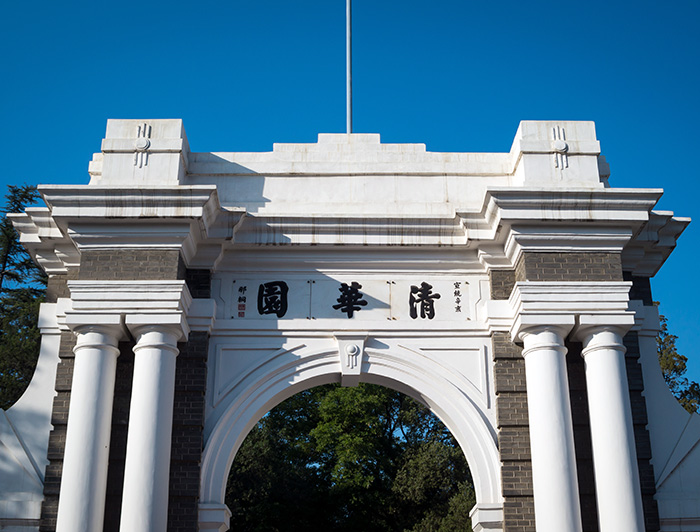
Located in northern Beijing, where the royal gardens of the Qing Dynasty once stood, Tsinghua University is positioned as one of the leading universities in China, ranking #3 in Asia and #25 globally, according to the QS Ranking 2024.
The university is divided into 20 schools and 57 departments, covering a wide range of disciplines, including sciences, engineering, arts and literature, social sciences, and medicine. It has more than 37,000 students, over 4,000 international students, and more than 6,000 administrative and professional staff.


